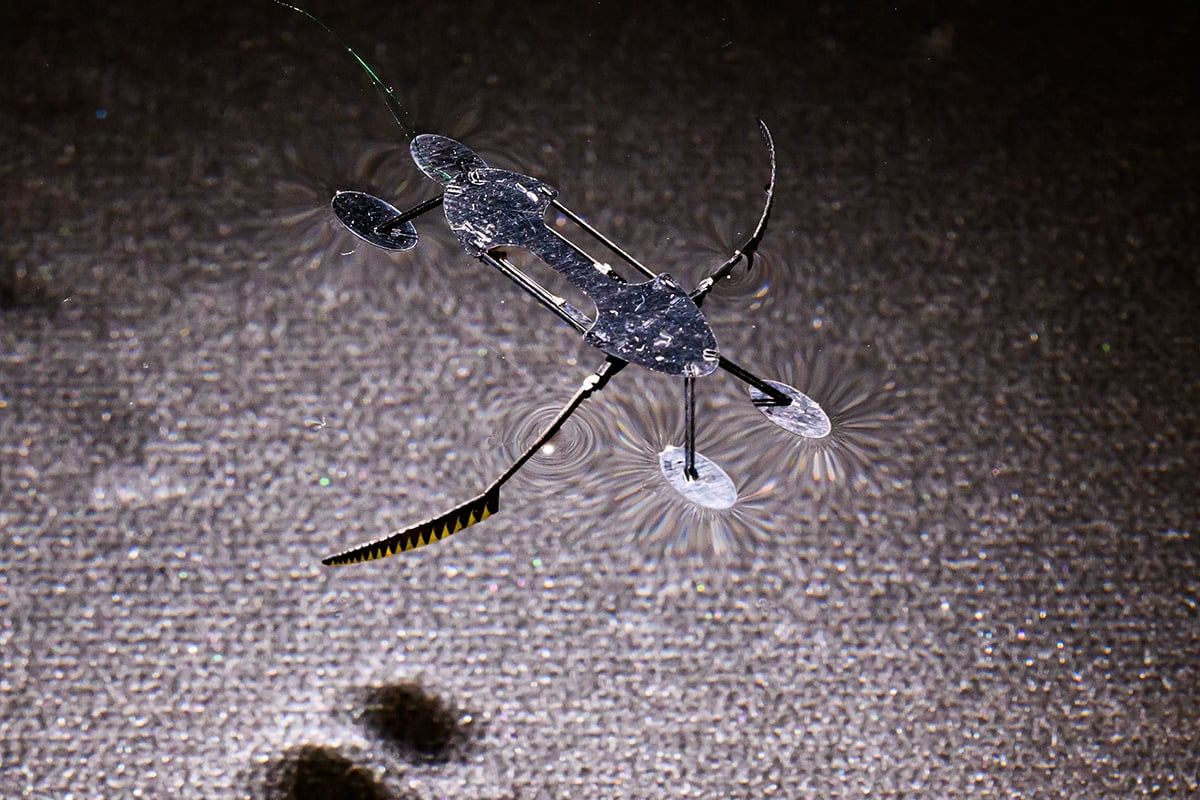WSU mini-robots mimic insects to get stronger, faster: ‘They can do exactly what we want to do’

As both a fly fisherman and a mechanical engineer, Conor Trygstad is trying to imitate bugs.
Insects are the “perfect machines,” faster and stronger than humans relative to size, Trygstad said. They are also tasty to the fish he’s trying to catch, so he has spent hours studying them to perfect his lure.
“I always look at the bugs out on the river. You are always trying to mimic bugs to fool a fish into eating your fly,” he said.
Fishing in the Palouse between his PhD studies at Washington State University, water striders are commonly seen skimming across the surface of the water.
“I became fascinated with seeing how quickly water striders move on the water. They have to be fearless so they don’t drown. Where I’m fishing, they’re racing through a rushing river with ease,” he said.
After mimicking the insect on his lure, Trygstad wondered if he could mimic them in his lab.
The two insect-like robots developed from his research are smaller, lighter and faster than micro-robots others have created in the past. They could someday be used for water safety testing, robotic-assisted surgery, artificial pollination, search and rescue, and other purposes.
“Looking at the mechanisms that these insects use, they can do exactly what we want to do. They can transmit forces much larger than their size and weight, and they work in teams collaboratively to build big structures,” Trygstad said.
What are the bug bots?
There are two designs developed by WSU’s School of Mechanical and Materials Engineering. One is a crawling mini-bug only 8 millimeters long and 8 milligrams heavy. The water strider is a bit larger at 2 centimeters long and 55 milligrams of weight.
Both move about 6 millimeters a second and can carry 155 times their body weight. If a human of an average weight could lift that much, they would lift over 25,000 pounds.
“At the small scale where we work, especially with microrobots, the absolute perfect machines that we can reference are designs off the ones that nature has developed over millions of years of evolution,” Trygstad said.
The machines are not as strong or fast as many actual insects. An ant typically weighs up to 5 milligrams and some can move at almost a meter per second. But the tiny robots open up many possibilities in how they can be used.
For the crawling minibug, Trygstad imagines a swarm working together in a factory to autonomously build small, hyperspecialized electronics.
“You would have a kind of micro-assembly line where these bugs could interact with other robots to move around tiny parts to build smaller robots or circuitry,” he said.
Because of its ability to operate on the surface of the water, a water strider could be used to monitor water for environmental toxins at a much more constant basis than currently possible.
“Our water strider could go around the surface of the water and take data about the water – like temperature, pH levels, different chemicals. And all that could then be constantly being transmitted back to the technician,” he said.
In the “research and development phase,” these bugs are a long way off from commercialization, according to Trygstad.
How do the bugs work?
The minibugs are powered by a device called an actuator, which acts as the spine for these two devices.
An actuator is a small carbon fiber beam with a special wire connected to either end of it. As the wire is heated, the beam bends and contracts. Then as the wire is cooled down, the beam stretches back out. By repeating this heating and cooling process, displacement energy is created that is used for locomotion and other mechanisms of the robot.
These beams also use a “shape memory alloy” that “remembers” the shape it was before and will always return to the same shape as it is heated and cooled. Unlike typical motors that move robots, this process does not use any moving parts or spinning components.
These would be too large and cumbersome for these machines.
The design is building upon previous research at WSU, which constructed an actuator that was approximately 6 millimeters. Trygstad used a new fabrication technique to miniaturize the actuator down to less than a milligram, which then allows the minirobots to become smaller as well.
“The actuators are the smallest and fastest ever developed for micro-robotics,” said Néstor O. Pérez-Arancibia, a WSU engineering professor who oversaw the project.
Two shape memory alloy wires 1/1,000th of an inch in diameter can create enough energy to allow robots to flap their fins or move their feet at up to 40 times per second or lift more than 150 times their own body weight.
The main limitation of the current technology is that the two robots are required to be connected to an external power source. The WSU researchers’ next steps are to use tiny batteries or catalytic combustion to allow their robots to be untethered from a power supply.
“We want to integrate on-board power to remove that tether constraint and then make these fully autonomous so that they can function on their own and they can navigate their environments intelligently,” Trygstad said.
WSU robots modeled on insects may be smallest, lightest, fastest of their kind